|
Interviews with
Utah Minutemen:
Doing the Job
Our Officials Refuse to Do
(News for
6/1/05)

Two Utah Minutemen
hoist
the Utah State flag near the Mexican border in Arizona.
(click on picture to enlarge) |
Summary:
You've witnessed the embarrassment of president George Bush
and Mexican President Vicente Fox. You've seen and heard
what the Utah press has reported. Now consider the
first-hand accounts of several brave Utah Minutemen who
assisted in proving that our nation's borders can be guarded
against the illegal hordes invading our nation.
Topics:
Introduction
to Utah Minutemen
Part I:
Border Activity, Patrols, & Local Communities
What went on along your section of the border during your
pre-MMP tour?
Wally and Jeff, did you see similar
border activity once the MP project officially began?
You speak of "patrols". How were you organized?
What is it like in the U.S. communities
along the border?
What separates the U.S. from Mexico?
The Utah media reported that there was a broiling local
"controversy" over your efforts down there. How were you
received?
Part II:
How Illegals Play the Game
What happens to illegals who are caught by the BP?
What were your impressions of the illegal aliens you
personally encountered?
What did the illegals do once they crossed into the U.S.? Q:
What was the extent of your involvement in apprehending
illegal aliens?
Part III:
How Did the U.S. Government Treat You?
What
were your observations and impressions regarding the BP?
Did you ever see any planes during your service there?
What do you think of the actions of your
government with regard to illegal aliens?
How were you treated by your government?
They threatened to arrest you for entering a public area to
communicate with them?
Question: What do you think of Pres.
Bush's accusation?
If you weren't vigilantes, what were
you?
Part IV:
Threats by Mexican Government & Drug Cartel
Your lives were publicly threatened by a Mexican drug lord
being held in federal prison. Were you fearful?
You knew about these rumors before you went down there, right?
How did that affect you?
Did you witness any violence?
Final
Thoughts: What of the Future?
Who is at fault for illegal immigration?
What do you think of the guestworker amnesty proposals?
So who is pushing for amnesty for illegals?
How
does this problem impact Utah?
Will
the MMP happen again?
Introduction to Utah Minutemen
Russell Sias spent
January, February, and part of March 2005 on several border
patrols in both Arizona and Texas prior to the official start
of the Minuteman Project (MP) in April 2005. As detailed in
this article, his experiences offer a stark contrast to the
experiences of our other interviewees. Russell reveals a very
different picture of the behavior of the U.S. federal
government, Mexican government, illegal aliens, and even drug
traffickers.
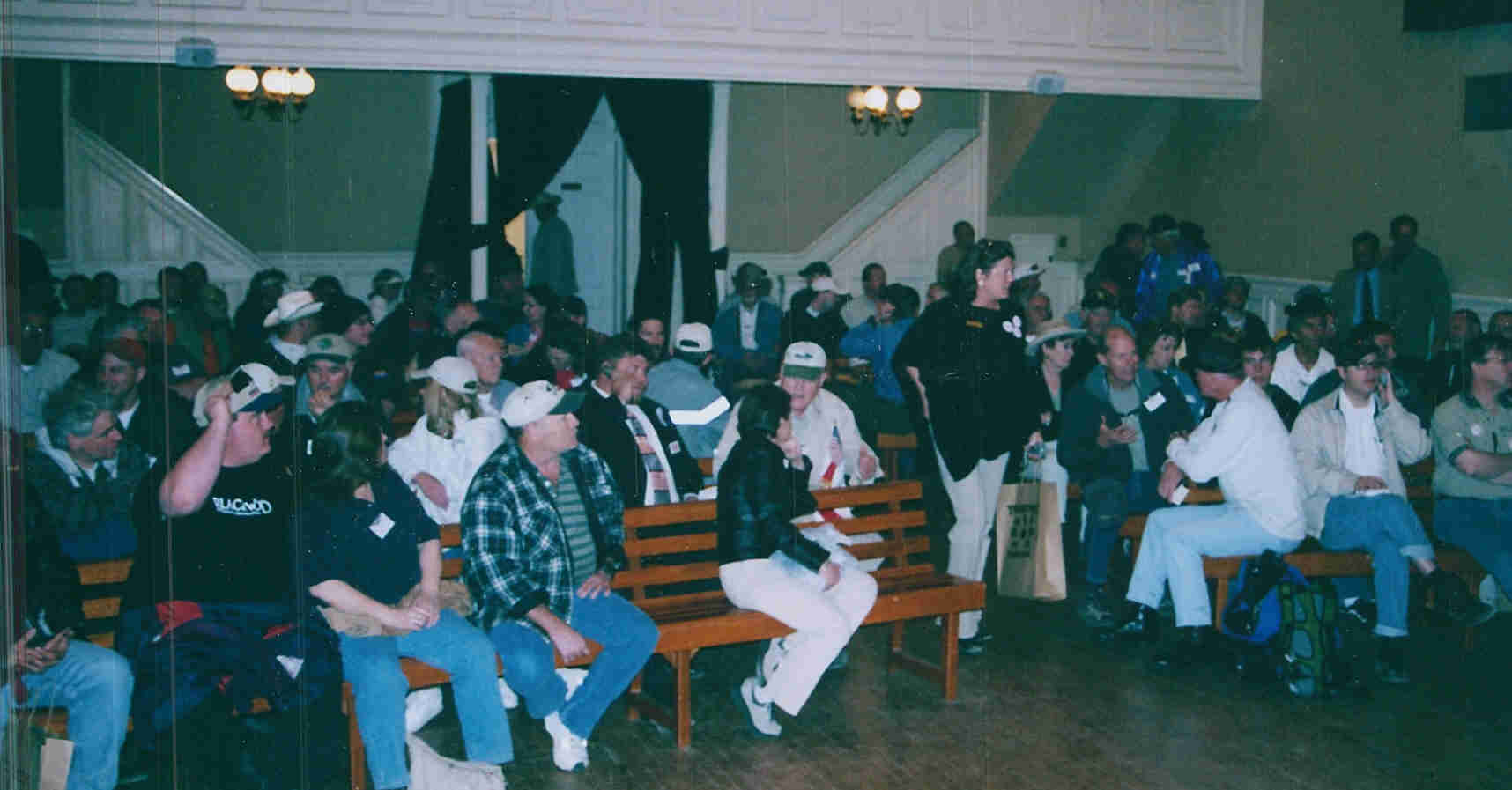
Orientation meeting in Naco, Arizona, for
Minutemen from all over the United States.
(click on picture to enlarge) |
Wally McCormick and
Jeff McNeil served on the Arizona-Mexico border along a
23-mile stretch between Palominos and Douglas from March 30th
to April 4th, 2005.
Alex Segura served in
the same area, performing different shifts daily from April
2-8, 2005. He went alone and met up with three other Utah
Minutemen there.
Back to Topics
Part I: Border Activity, Patrols, & Local Communities
Question: What went on along your
section of the border during your pre-MMP tour?
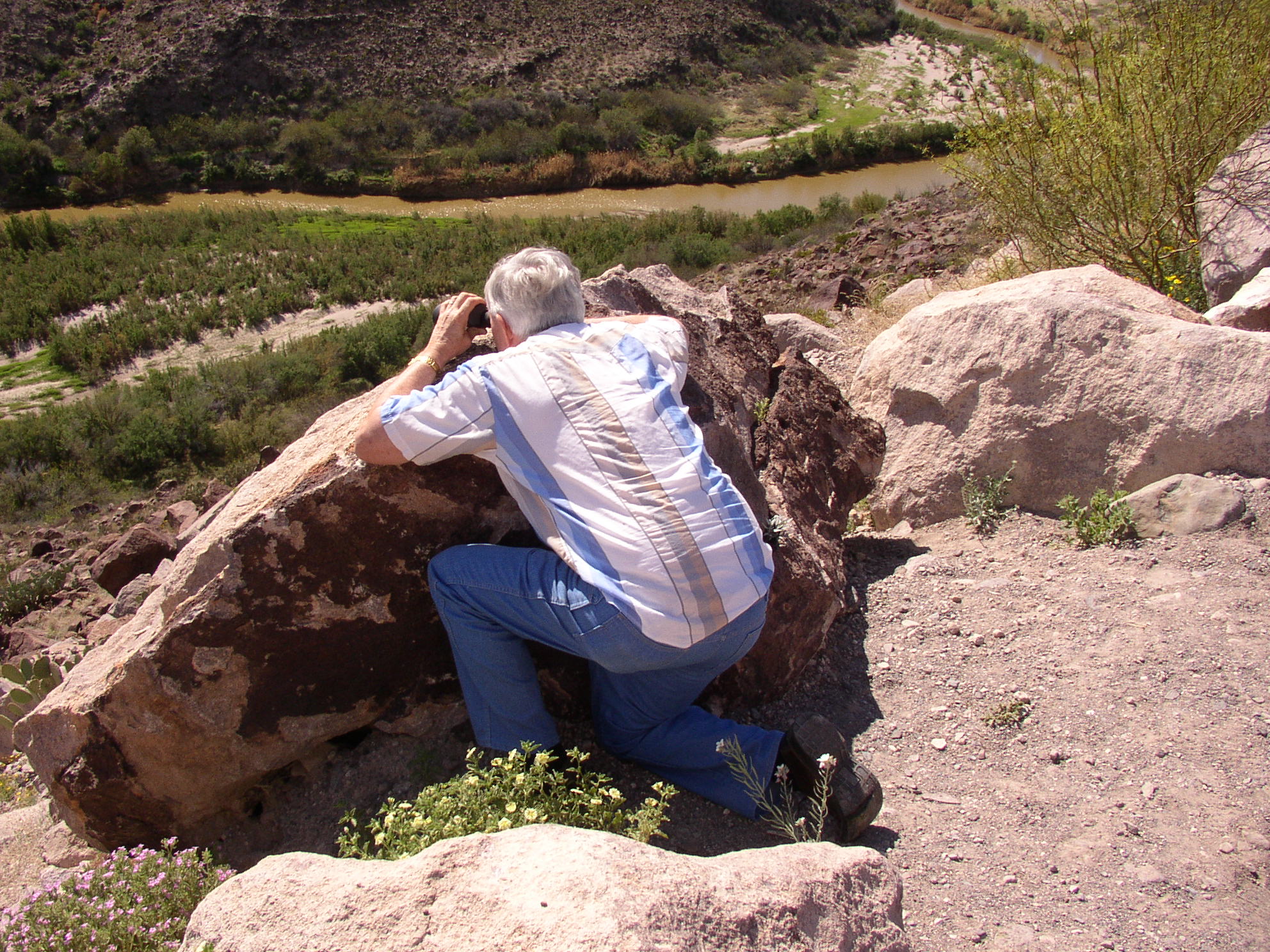
Russell Sias surveying border area.
(click on picture to enlarge) |
Russell Sias: I made
several patrols from January to March 2005. During my first
experience, we were about 25 feet off the desert floor. We
witnessed seven groups of people, composed of 15-20 people
each, out in the desert on the Mexican side. They waited there
until dark. A half-hour or so after dark, these groups began
to cross the border. We called the Border Patrol (BP). They
arrived and confronted one of these groups. The group that was
confronted scattered out in the desert within a quarter mile
or so along the U.S. side of the border. During the 90 minutes
or so that it took to round them all up and get them loaded
into vans for the trip back to the Naco Border Patrol station,
the other six groups vanished into to night — and into the
interior of the U.S.
The same scene is repeated,
night after night. During my border watches, rarely and hour
went by that I did not see similar scenes played out. The
vastly outnumbered BP agent(s) often meet the overwhelming
odds of six or seven groups of illegal aliens coming across
the border at once. They can only deal with one group at a
time. Buses, vans, sedans, and trucks would drop them off
during the day along the Mexican Highway #2, and they would
spend the day hiking across the desert and then sit just south
of the border until just after dark, when they would make the
final short trek across our southern border…
Those who take their [illegal
alien's] money are despicable. I watched 3 buses in 10 minutes
dump people off at noon along the Mexican highway. It was
unremarkable to see 150 people be dropped off in half an hour
or so. Then, later in the day, towards evening, we could watch
through a scope and see their campfires and hear their
conversations while they waited for dark. Often, these
campsites were only a few hundred yards from the border.
Jeff McNeil: A BP agent
told me he caught the same guy six nights in a row and on the
7th night he didn’t. He assumed the guy got through that time.
Russell Sias: I drove a
truck similar to a typical "coyote" [i.e. smuggler of human
beings]. On one night, I was parked by a school and saw nine
agents vehicles chase one coyote [drug smuggler] in a Mercedes
no less, as he ran towards the border to escape their pursuit.
He drove right directly into the desert, eventually getting
stuck and abandoning his car. He was able to escape, and by
leaving his car, make it back across the border. They
impounded the car, along with 10 pounds of drugs. The way the
system is presently working, next week, he can go buy that car
back for pennies on the dollar — at a BP auction! I've been
told many buy their same cars back the next week at these
auctions. From my conversations with the BP, I learned that we
have several coyotes operating right here in Salt Lake valley.
When an illegal alien makes an arrangement with a coyote, the
coyote agrees to take the criminal illegal alien to some
particular location, such as Salt Lake City, or Provo, Utah.
Utah is one of the favorite destinations because of our very
lax enforcement of immigration laws. Until very recently, we
freely granted criminal illegal aliens driver’s licenses, and
now that the REAL ID act has been passed to limit the giving
of driver’s licenses, we now give them a Driver’s Privilege
Card instead! We must begin to ask ourselves why we give them
any sort of privilege, after all, they are criminals.
Back to Topics
Question: Wally and Jeff, did you see
similar border activity once the MP project officially began?

"Station 6" is located
at
the top of this dirt road.
(click on picture to enlarge) |
Wally McCormick: Not
while we were there during the Minuteman Project. (MMP). We
served at Station 6, same as one of the places that Russell
and Chris Simcox, who was the head of this phase of the MMP
patrolled.
Russell Sias: They
[illegal aliens] were warned not to cross there while the MMP
patrolled the areas. Still, 200-300 tried during the MMP
[official time period]. Mexican enforcement folks, during the
month of the MMP, took great pains to patrol the southern side
of the border, and hauled those attempting to cross our
border, to either side of the project, advising them that the
MMP were patrolling and so it was unadvisable to cross at that
point of the border. Still, some did attempt to do so.
Wally McCormick: Group
Beta, basically the Mexican border patrol, came to take
illegals away from our area of the border, to probably another
crossing point.
Jeff McNeil: They were
more like "Search and Rescue" than a border patrol.
Alex Segura: Grupo Beta
(Mexican human rights) were stationed to encourage crossers
approaching the 20-mile MMP teams to return home. We were told
the Mexican military were also in the area. The Grupo Beta
wore bright orange shirts and drove new orange trucks. We
usually had one to two trucks within our binocular vision,
with several orange coats per truck. The local ranchers told
us that they had never seen these "orange coats" before. We
watched the orange guys with our binoculars. From our lawn
chairs, armed with walkie-talkie radios and bottled waters. We
watched them drive around in their orange trucks. They would
park under trees and eat their lunches. Get out and walk
around. Go under bridges where migrants camp. We would from
time to time see people who may have been migrants get in the
backs of their orange trucks.
Russell Sias: During my
stay in the area, I never saw these orange trucks. Not even
once.
Alex Segura: I can also
add that while my group was posted at our section not one
illegal crosser traversed the well-worn paths. They did not
walk through the openings in the barbed wire as they normally
do. Our presence stopped illegal crossings in this area —
normally commonplace.
Back to Topics
Question: You speak of "patrols". How
were you organized?
Alex Segura: In our
sector, teams of Minutemen from two to five set up on a
hillside along a dirt road ten paces from the border of
Mexico. I think we had a total of nine teams. Although too far
to talk, you could see a Minuteman team on either side of you.
We communicated with each team via walkie-talkie radios. It
was very well organized. We had a MMP supervisor driving by
periodically. Each team was encouraged to fly their state
flag. A New York flag was flying from the team to our west and
a Florida flag flying from the team to our east. Our team flew
an American and Utah flag combo. For 8 hour shifts around the
clock, Minutemen — a giant neighborhood watch — groups were
armed with binoculars, cells phones and handheld walkie-talkie
radios. We set up lawn chairs and umbrellas. In short, we were
noisy and visible. Chris Simcox had said noise was a good
thing at a Minuteman post to deter would-be crossers.
Back to Topics
Question: What is it like in the U.S.
communities along the border?

From left to right: Dawn Walker, older
daughter, and Terry Walker.
(click on picture to enlarge) |
Wally McCormick: It is a
war zone on the U.S. side of the border near Naco where we
were stationed. Near Naco we met a young family, the Walkers,
who had four young daughters. They have a private fence around
their entire property. Even with this fence, at night, they
would turn on their floodlights and see 50-100 illegals camped
out in their backyard. The illegals would bang on their doors
demanding food, water, drugs, cigarettes, and money and
threatened that if they didn't provide such they would be
sorry. If they stepped out of their door, they were yelled at,
flipped off, and men would grab their genitals. They are too
poor to sell their property. Each family member has to wear a
gun on their person all of their waking hours. I ask, "How can
this possibly be happening in the United States?"
Dawn said the Douglas Hospital
has closed completely, and Bisbee has closed their OB
Department and is on the verge of closing down completely.
Treating illegals without payment has forced them to close,
and if they didn't [treat the illegals], the government would
have closed them down because it demanded that hospitals treat
illegals even if they don't pay. She also said that they took
all of their children to self-defense classes. They never knew
if those in their yard were tomato pickers or drug runners.
Russell Sias: I also met
a terrified mother of three, a ranch owner, whose twelve-year-old carried a gun
— to go play on their very own
property! All of the family NEVER went outside without three
things: A cell phone, a walkie-talkie, and a functioning side
arm. This is not uncommon. This family cannot sell their
property because no one is willing to buy it. They are stuck
there — because of the criminal illegal alien trespassers.
Alex Segura: The Walkers
are ranchers and live on 800 acres of land that has been in
the family since the 1880s. Their ranch begins at the Mexican
border. They came to our Minuteman post requesting that
Minutemen be stationed on their nearby property. Robin told me
she hears gunshots every night on her ranch and has no idea
exactly where it is coming from. Since the Minutemen arrived,
she claims the gunshots have stopped.

The Walker family's barbed wire fence does not
stop the illegal hordes from camping out in their back yard.
(click on picture to enlarge) |
Recently, a drunken illegal
alien wandered onto their ranch at night. She was home alone
with her children. The illegal alien pounded on their front
door. Robin said she and her terrified children crawled on
their stomachs to the back of their house to get away from
him. While retelling this event, her eyes were filled with
both terror and humiliation. The family's ranch is trampled by
illegal crossings. Years ago, they said their ranch was
peaceful and safe; that it was rare to see illegal crossers.
The husband, Terry, said he was
recently on his property and was astounded to count over 200
illegal crossers in a group nearby. He said he called the
border patrol on his cell phone. He was told by the woman on
the phone that it was not possible to see 200 hundred crossers
because they would never cross in such a large group. As he
was being told this, the 200 were crossing right before his
eyes!
This ranching family thanked us
profusely. They said if we needed anything — food, showers,
rest — we were welcome in their home. The gruff rancher
husband had tears in his eyes when he said goodbye, thanking
us.
Jeff McNeil: The couple
could never both leave their home. They had to take turns
leaving their home to work or go into town. The other one had
to remain to defend the home. They told us that this was the
first time in 5 years that they had been able to sleep prior
to the MP.
Back to Topics
Question: What separates the U.S. from
Mexico?
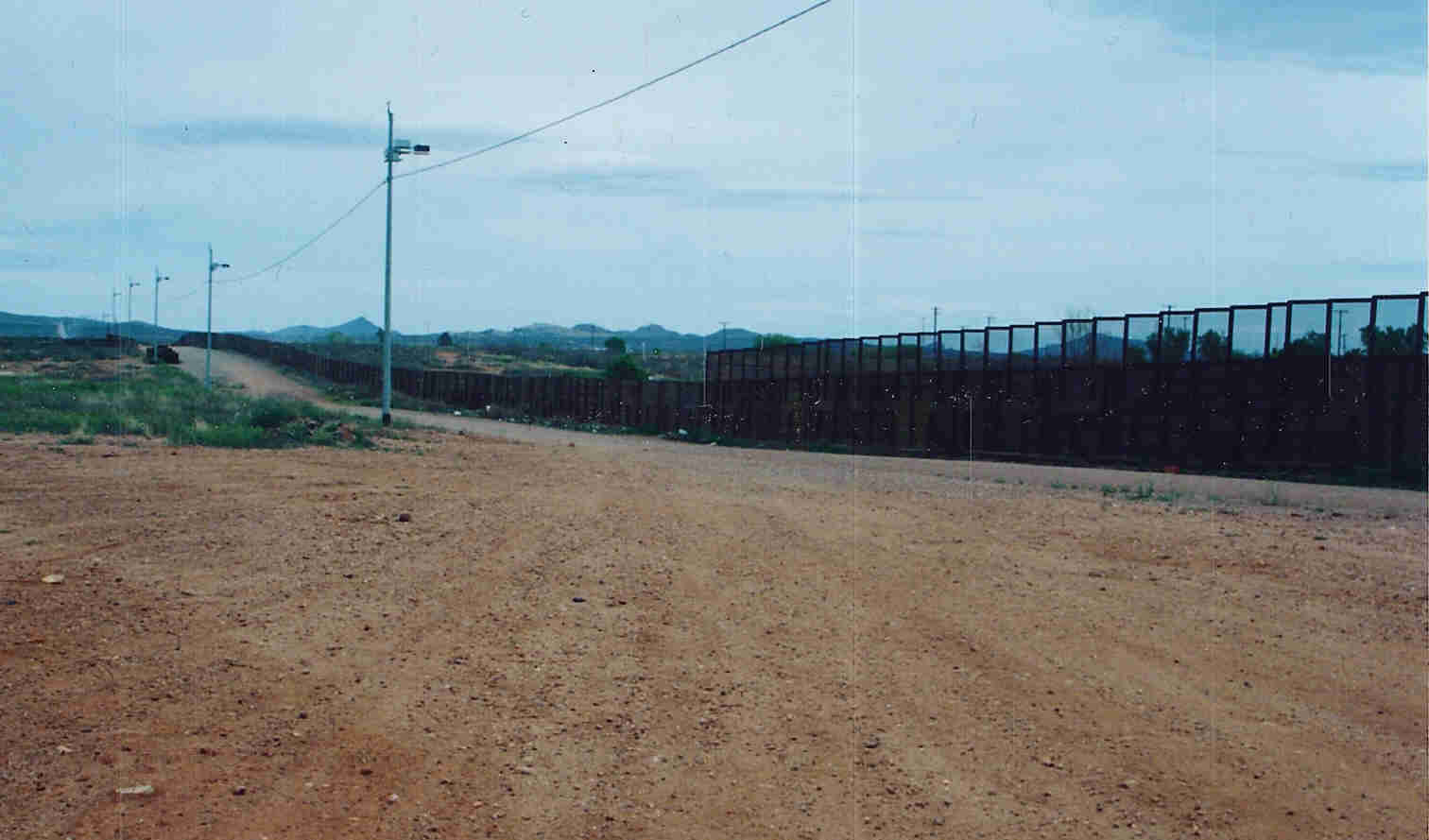
Don't let this fence fool you. It runs
about 1.5 miles and then turns into broken fences like the
ones featured below.
(click on pictures to enlarge)
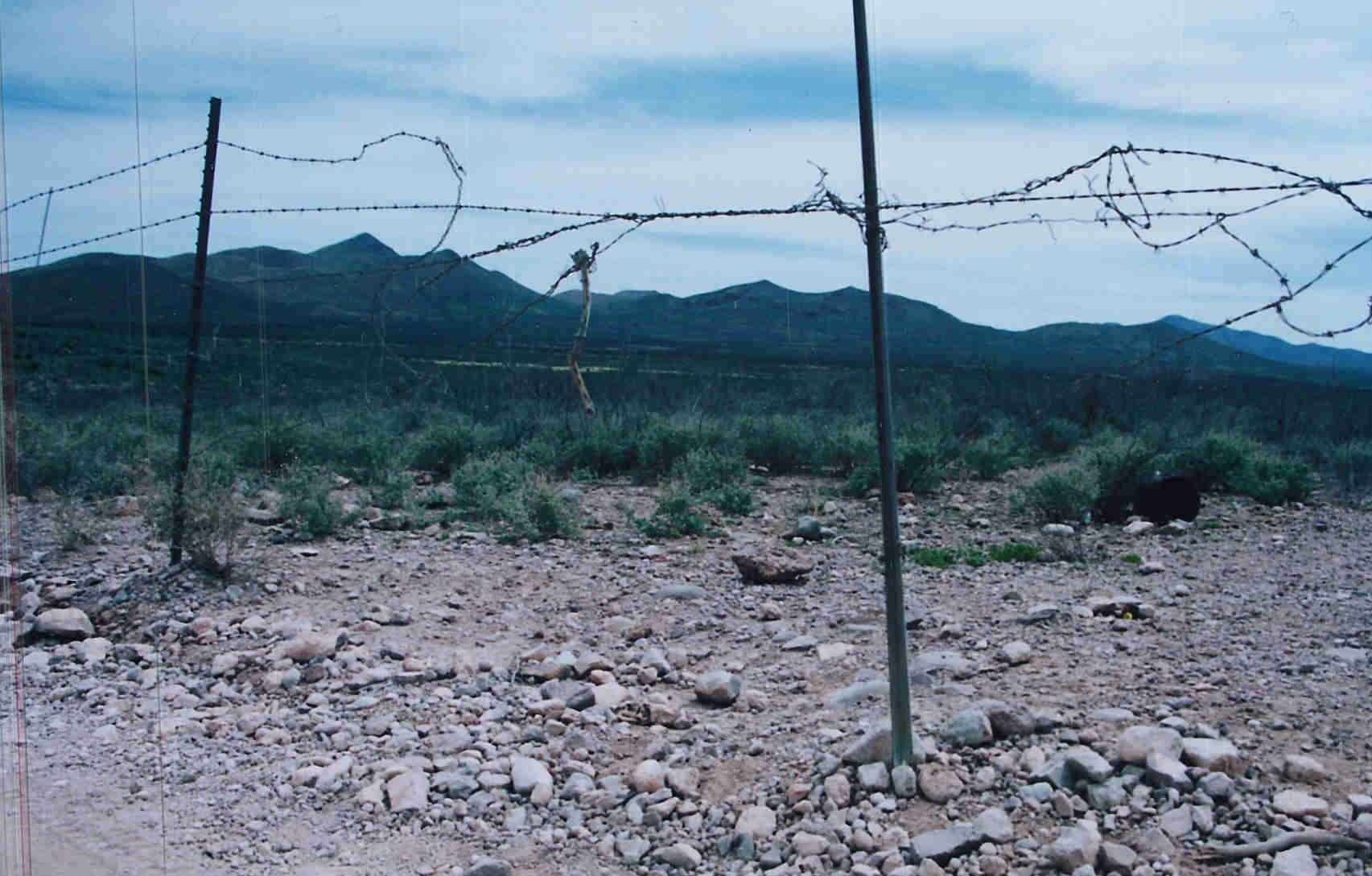
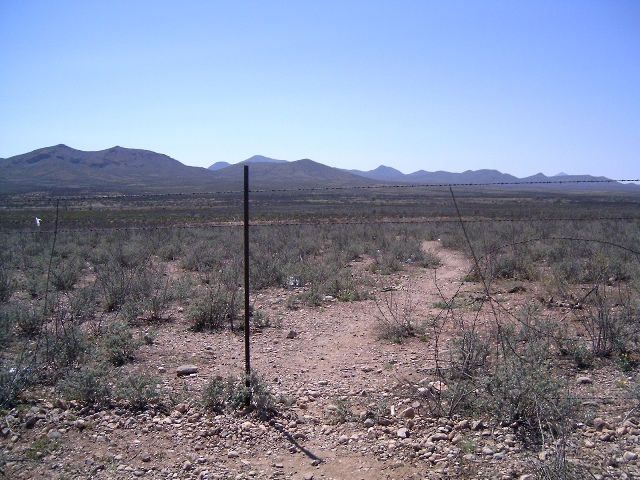
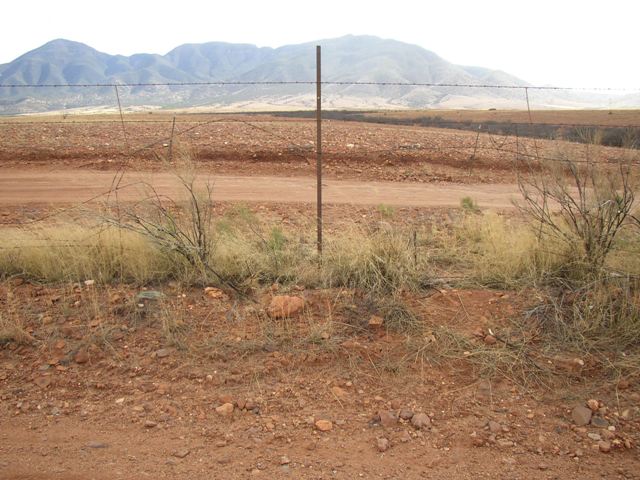 |
Russell Sias: Along our
southern border, there is 60 feet of public right away along
the border. The barbed wire fence is two feet inside the
border, and the remaining 58 feet is a gravel road on the U.S.
side of the border. Ranchers and the public, along with the
BP, use this road. One rancher had a big sign posted saying,
"No Trespassing." When I spoke to him, I asked him, "You do
understand that your sign is on public property, don't you?"
He responded, grinning, "Well, it works." Outside Naco but
probably within the city limits, there was a vertical railroad
iron every 8 inches apart. But drive 300 yards further away
from town, and you'll find the 4-strand barb wire fence.
Wherever I drove along the border fence, I doubt that I saw
over a 50-yard section of fence that did not have a wire cut
to allow easier access across or through the fence.
Alex Segura: The barbed
wire border fence is a joke; just a barbed wire fence like we
use around cattle or our local farms. It's about shoulder
high. Our team's section of fence, about a two-block area, had
four crossing areas. The barbed wire has been stretched and
cut to accommodate crossers. On the Mexican side, trails
through the desert shrubs lead up to the passage holes in the
barbed wire fence. Some of the holes are large enough to
accommodate a pair of crossers walking hand in hand. The
Mexican side is desolate except for a train track and a
highway in the distance. Desert foliage was crisscrossed with
paths leading to the fence.
Back to Topics
Question: The Utah media reported that
there was a broiling local "controversy" over your efforts
down there. How were you received?

Local citizens rally in support of the
Minuteman Project.
(click on picture to enlarge) |
Alex Segura: Our arrival
has been controversial among the locals. There was quite a lot
of talk about the Bible College. The Minutemen who stayed
there said pastors in some church services, focused their
talks on their gratitude for the Minutemen. One pastor asked
for Minutemen to stand and be recognized. There were only
about five us in attendance. The pastor then told the church
people to go to us and shake their hands. But the churchgoers
approached and hugged them! Some held onto them like they were
a life safer! A line formed as mothers, children, old ladies,
teens embraced the Minutemen. I did have locals express
discord about MMP, but they were the exception in my
experience.
Our night shift had said that a
rancher had pulled up in his truck, emerged from the darkness,
holding the hands of his two small children and thanked the
Minutemen over and over. The night shift Minuteman told me
that that the rancher had tears in his eyes as he thanked
them. The Minuteman, who listened to the rancher and told me
of the experience, is a tough, muscular, no nonsense former
military guy. But when he told me this story about the
rancher, he said his eyes welled up with tears too when the
rancher expressed his gratitude.

Minuteman organizer, Chris Simcox, is
interviewed by a KSL reporter wearing a "Vote for Pedro"
T-shirt.
(click on picture to enlarge) |
When a group of us were at a
local cafe, a local guy came up and grilled us. Gave us his
stories about his mother's property being ransacked by
crossers. He then wrote down the name of a section where he
asked the Minutemen to go to.
I told the locals that would
give me suggestions that they should contact the leadership of
MMP with their referrals. I was a peon just following the
orders. If you were a Minuteman, someone would inevitably
request you patrol some section. It absolutely makes my blood
boil to think of government letting these hard working
American citizens' ranches literally be destroyed by this
invasion! I told them all that they are heroes. Most said they
will never leave their ranches!
Back to Topics
Part II: How Illegals Play the Game
Question: What happens to illegals who
are caught by the BP?
Russell Sias: All the BP
can do with them is to keep them for the night, and then the
next morning, throw them back across the border so that they
could try to cross again the following evening. I spoke with
one BP agent, who said that he had picked up the same fellow
six nights in a row. He didn’t see him on the seventh night,
so he said he assumed that he made it without getting caught
the seventh night.
If the illegal is an OTM [Other
Than Mexican], they ask them if they have relatives in the
U.S. If they are smart enough to lie, the BP buys them bus
tickets and sends them to the destination they said that they
have relatives. Apparently our concerns about terrorism are
not worth the time or trouble to ask further probing questions
of the OTM’s.
Wally McCormick:
Twenty-five to thirty percent of those who cross the border
are OTMs. Most are from nations that are unfriendly to the
U.S., such as China, El Salvador, Iran, Afghanistan, and
Libya.
Back to Topics
Question: What were your impressions of
the illegal aliens you personally encountered?
Russell Sias: I went down
there with no sympathy for illegal aliens. I came back with a
little empathy for the people. Not enough to prevent me from
calling the BP and sending them back across the border, but
some. The treatment they are getting is atrocious. The real
bad guys are not the criminal illegal aliens. They are the
coyotes, and the employers who ultimately fund this whole
illegal process.
Wally McCormick: Most of
the illegals coming here will not, and do not, intend to speak
English or assimilate into our culture. They do not hesitate
to state that they are taking over California, Arizona,
Nevada, Mexico, and Texas and that the white race needs to
leave.
Jeff McNeil: The other
25% of those coming here illegally who are OTMs are coming for
purposes we don't know of. The BP told us that in 6 months
time, approximately 250,000 people were caught along the
southern border. They claimed to have only caught 1 in 4,
which is bogus because those who are caught just come right
back the next day and get in. Of those 250,000 who were
caught, 18,000 are known, convicted felons.
Russell Sias: I
interviewed many illegals. They saw no point in running away
from the BP. They were laid back about getting caught. Their
attitude was: Why work up a sweat running or attempting to
hide, when it is common knowledge that they can just try again
tomorrow?
Back to Topics
Question: What did the illegals do once
they crossed into the U.S.?
Wally McCormick: After
climbing through the fence, which has holes 3 to 4 feet wide
of which their trails from Mexico lead them to, they strip
from their clothing, and head to a campsite (an area in the
desert that their trails also lead them to, and they discard
everything including such things as Mexican ID, water bottles,
backpacks, blankets etc., and rest. After their rest they walk
about 1.5 miles North to Bisbee, Arizona, where all of them
wait in a field while one person, or their Coyote, walks over
to Safeway Market, puts in two quarters and wait for their
transportation to take them to their "safe" houses.
Russell Sias: I found
piles of identification in some of these dump station
locations.
Wally McCormick: It is
nothing to find 5-6 U.S. driver's licenses and U.S. Social
Security Numbers under different names with the their same
picture on all of them.
Alex Segura: Yes, and in
the possession of an illegal alien.
Russell Sias: Pickups and
SUVs come to get them and take them to safe houses in
primarily Phoenix and Tucson. Twenty-five to two hundred may
reside in one house. Within the MMP area, there is a power
line running northward into the desert from the border area.
Each power pole is marked with a number. Aliens are assigned a
specific power pole number and are told to go there and wait
to be picked up. One can find drugs, identification cards,
diapers, candy wrappers, etc. there. I saw 20'x20' areas where
you couldn't see the ground because of all the garbage and
trash left behind by these illegal aliens.
Wally McCormick: Several
hundred volunteers pick up 2 million pounds of trash each year
in the Douglas/Naco 23-mile area alone. Pristine desert land
is being destroyed. Where is the Sierra club?
Alex Segura: Our area was
littered with many Gatorade bottles. Many, many plastic bags.
Tins of foot fungicide. Deodorant cans. There were endless
numbers of cans, sweatshirts, a hair brush, razors, a cell
phone, a little Bible written in Spanish, many backpacks,
sandals, tennis shoes, blankets, a powder puff, tuna cans,
Tequila bottles, beer cans, a well used address book in
Spanish. We found three one-dollar bills rolled up and covered
in dirt. One of our Minutewomen found a black ski mask that is
the type used by the coyotes — or smugglers of human cargo
into the United States. There were many toothbrushes and tubes
of toothpaste. It is heart breaking to see the beautiful
desert literally covered in trash. The trash is just spread
all over. If you walk a few steps there is some form of trash
within view. Many, many plastic bags fly on trees and shrubs.
The size of bags varies from those big, black outdoor trash
bags down to the small postcard sized plastic bags.
Where the hell are the
environmentalists on this issue of the unbelievable amount of
trash? Is there anywhere else in the United States with such
out-of-control environmental destruction that gets so little
environmental attention? It is perplexing.
Russell Sias: I spoke
with a military police officer at Fort Huachuca. He told me
that approximately 150 aliens were apprehended on Fort
Huachuca every night. That is a 3-4 day walk from the border.
Most of the deaths happen there. Coyotes simply leave behind
anyone who cannot make the trek to die in the desert. During
the winter, a six-month pregnant woman was left in one of the
desert canyons — her dehydrated body was found by some one
hiking in the area.

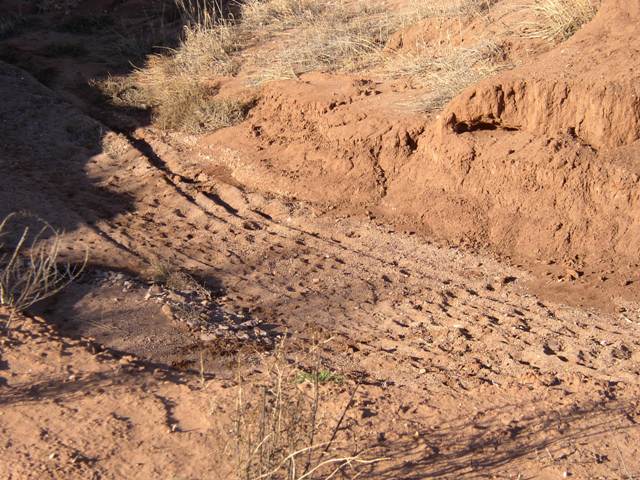
This is a wash used
by
illegals to minimize their profile as they invade the United
States.
(click on picture to enlarge) |
Wally McCormick: When
they come across the mountains they frequently walk in washes
and gullies [to avoid being spotted]. You can hear them if you
are quiet. At one of the Stations manned by the MMP on our
watch, near Sierra Vista, the MMP observed a person drive up
to the foot of their hill, drop off bags, and leave. One of
the MMP climbed down the Mountain and found 12 bags of
McDonalds lunches. She returned to their group and they
decided to continue to observe. About a half-hour later they
heard illegals coming out of the mountains and directly to the
McDonald's lunches. They then called the Border Patrol who
came to pick them up. The agent said, "Well, we've got all
14," and the MMP lady said, "Nope, there are 15," and motioned
up under the bridge where one of the illegals had plastered
himself to the ceiling of the bridge. The BP said, "You're
right, 15."
Russell Sias: The area
patrolled by the MMP is a shopping mall of illegal aliens. An
amazing number cross there. It is one of the easiest places to
cross.
Back to Topics
Question: What was the extent of your
involvement in apprehending illegal aliens?
Russell Sias: We called
the BP, but did not apprehend anyone. One group, on one of my
personal watches, came out of a gully, right at my feet! There
were 21 of them in the group. None spoke English, I pulled out
my cell phone, called the BP, and they all just sat down and
waited for the BP to arrive.
Some BP agents were equipped
with night vision and infrared. Once in a while you'd see a
helicopter.
Alex Segura: There was a
showing of border patrol helicopters, border patrol SUVs,
sheriff vehicles, border patrol on scooters. There was a
steady stream of law enforcement on this normally deserted
stretch of the border. The BP warned us to film everything we
did and to avoid contact with the aliens.
Russell Sias: Again, the
activity that Alex described was not evident prior to the MMP
kick-off date of April 1st. Rarely did I, while out on the
border in January, February, and part of March see anyone. On
occasion, I would see a BP vehicle or a helicopter, but I
never saw any sign of local law enforcement.
Back to Topics
Part III: How Did the U.S. Government
Treat You?
Question: What were your observations and impressions
regarding the BP?
Jeff McNeil: Prior to the
MP, the BP response time was 2-2.5 hours. They responded in
less than half that time while we were there.
Wally McCormick: The BP
did respond with their limited resources while we were there.
The Walker family said they had never seen so many BP agents
as they did while the Minutemen were there.
Russell Sias: The federal
government moved 500 additional BP agents into the 23-mile
zone of the MMP project because the Minutemen were there.
President Bush won't tell you, but that's what happened. These
were NOT 500 additional agents — they came from elsewhere
along the border.
Wally McCormick: In order
to better track the illegals, the BP would drag tires on the
back of their SUV's to smooth out dirt roads and areas, then
they could track movement by returning to the same area and
looking for footprints crossing the dirt road along the border
fence.
Russell Sias: They would
tell us to please stay out of the barrow pit as our tracks
would confuse their searches.
Back to Topics
Question: Did you ever see any planes
during your service there?
Jeff McNeil: Wally and I
saw only one plane, but it turned out to be a MMP plane.
Back to Topics
Question: What do you think of the
actions of your government with regard to illegal aliens?
Wally McCormick: I have
asked the Governors office, the Attorney General's office, the
Homeland Security Office, and numerous law enforcement
offices, and they don't have a clue as to how many illegals
would constitute an invasion. I asked the ICE Office in Utah,
the same question and his answer was, " We already have been
invaded." The people invading our nation have a designed
program to take back the states of California, Arizona,
Nevada, and New Mexico and Texas. They call it Aztlan. I spent
some time in Los Angeles and Orange County California. They
are very flagrant about that down there. La Raza and others
claim to have 15 million warriors already in the U.S. at their
beckon call when they are ready to take over and push the
white man out. They have put up billboards that say "Los
Angeles Mexico."
But you asked about our
government? Yeah, right. Let me tell you about our government.
Just after the project was over our government instructed the
BP to "stand down" and not to pick any illegals up so that
they could say the reason we were successful was because no
one was coming across. Up until the day we started, they were
catching 3,000 per day. Anther 12,000 were crossing that they
didn't catch. A former BP agent advised me that this isn't
unusual; that they alter the figures to obtain whatever they
need at the time.
Russell Sias: For years,
the government has been spouting the bogus number that there
are 10 million illegals in the U.S. I've been at this for 10
years and there are 3 million entering the U.S. each year. The
numbers do not add up! Bear-Stearns says that the current
numbers are likely now over 20 million illegals in the
country, and NO ONE knows how many terrorists are among them.
Recently, VP Cheney stated that we don’t know who they are, we
don’t know how many are here, we don’t where they are, and we
don’t know what their intentions are. Some numbers indicate
that 10% of Mexico’s population is in the U.S. illegally!
Jeff McNeil: We are being
colonized.
Back to Topics
Question: How were you treated by your
government?
Wally McCormick: Mr.
Nicely, the Public Officer, blamed us for setting off alarms.
It wasn't us. It was the American Civil Liberties Union (ACLU)
people. He never recanted his false accusations. The ACLU-type
folks climbed into gullies trying to catch us doing something
wrong. After 2-3 weeks, most of them went home because we were
law abiding. The rest hung around and smoked drugs.
Russell Sias: President
Bush called us vigilantes.
Wally McCormick: The BP
were not allowed to talk to us.
Jeff McNeil: Officially
they weren't allowed.
Russell Sias: I spoke
with every BP agent I encountered. They are absolutely harried
and understaffed. Like the little boy trying to keep back the
dyke with his finger. I had the opportunity to be there prior
to the actual date of the project, and so the BP were not
under the direct command not to communicate with the MMP
people, and were pleasant to talk to about the problems.
Wally McCormick: Come our
tour, they were gung-ho, giving us thumbs up signs as they
drove by.
Alex Segura: There were
BP supervisors who would drive around and talk to the press.
They would spin a line worthy of Bush and DHS [federal
Department of Human Services]. But when there were no
supervisors around, the rank and file border patrol would
occasionally speak to us. It was brave of them as they wear
name badges. One border patrol agent told me that the Mexican
"humanitarian," orange-coat guys routinely shake down the
crossers. He laughed when I called them humanitarians. Another
agent told me that the BP was very glad we were there. When we
asked about the so-called sensors Minutemen were setting off,
he laughed and said the spokesmen were saying what they'd been
told to say. He gave me a thumbs-up when he drove off. They
also communicated that the illegal crossing activity is very
well orchestrated and run.
Jeff McNeil: The BP
wouldn't even allow us on their administrative office
premises. They told us that if any of us so much as set foot
on that property, they'd arrest us.
Back to Topics
Question: They threatened to arrest you
for entering a public area to communicate with them?
Wally McCormick: Yes. We
probably should have challenged them on that, but we were
there for other reasons.
Back to Topics
Question: What do you think of Pres.
Bush's accusation?
Jeff McNeil: He might as
well have called us insurgents and arrested us.
Wally McCormick: Did you
ever hear him recant what he said? Bush could not afford for
us to be successful. That is why the BP was ordered to stand
down after we left. Our elected officials should step down or
be removed from office. Polls show 70% or more of the Citizens
demand secured borders, and our elected officials, for
whatever reasons their agendas are, they have blatantly
refused to do so. They have taken oaths to
protect the United States and the Constitution yet they have
done everything within their power to do just the opposite.
It's as if they refuse to accept that the Constitution exists.
Back to Topics
Question: If you weren't vigilantes,
what were you?
Russell Sias: I like the
way a friend of ours put it: We were undocumented border
patrol agents.
Back to Topics
Part IV: Threats by Mexican Government &
Drug Cartel
Question: Your lives were publicly
threatened by a Mexican drug lord being held in federal
prison. Were you fearful?
Wally McCormick: Yes, he
said that the M13 gang from El Salvador were going to come
down and lop off our heads. It was also announced by Vicente
Fox that that 1,000 Mexican soldiers were being sent to the
border. We believe they [the rumors] were invented to scare us
away. But you know what? We weren't nearly as afraid of what
was coming across the border as we were of what might be done
to us behind our backs by our own government.
Russell Sias: Drug
smugglers are dangerous. They'd just as soon shoot you as ask
for your name.
Back to Topics
Question: You knew about these rumors
before you went down there, right? How did that affect you?
Wally McCormick: For me
it required many prayers. At first I wasn't going to tell my
family. I didn't when I first heard about the program. I was
approximately the 200th to sign up. Nearing the time I told
one son, and he said I have to tell the family — as this has
to be a family decision. They agreed that, because of my
devotion to this cause and my country, I should go.
I prepared a living will and
called my family and grandchildren together and told them what
I must do. It gave me an opportunity to say goodbye to each
one in case I did not come back. Vicente Fox was sending 1,000
thousand soldiers to the border (not matched by American
Soldiers), the Leader of the terrorist MS 13 gang put out the
word to his gang to kill us, a Latino group from California
was coming over, and the ACLU was coming to watch the
Americans watching the illegals for the illegals' safety. They
were NOT down there to make sure the American's were safe, but
to see if WE stepped out of line. Only in America! Ha ha!
And
I just felt that president Bush couldn't let us be successful.
So, yes, I felt our lives were in great danger.
Back to Topics
Question: Did you witness any violence?
Russell Sias: I saw drug
smugglers, but no violence.
Wally McCormick and Jeff
McNeil: No.
Alex Segura: We did see a
young man appear among the orange guys who had a huge rifle
slung over his shoulder. The Minutemen in my group knew the
rifle make and said it had a scope. This guy was in his 20s,
in a tee shirt, black pants and baseball cap. No uniform. Our
entire line watched him through binoculars. He would zigzag
around. Talk to the orange coats. Zigzag more. Our radio
walkie-talkie info finally declared they thought he was
police. He eventually walked out of view over a hill. When I
related the event to a local rancher who stopped by to talk
with us, he told me that the guy was definitely a coyote. He
also said anyone out there on the Mexican side is part of the
bribery and smuggling even if they are government employees. A
Mexican national farmer approached me later on horseback and
stated illegal crossers only want to work. Again, we had a
peaceful conversation.
Back to Topics
Final Thoughts: What of the Future?
Question: Who is at fault for illegal
immigration?
Russell Sias: Illegal
immigration is funded and enabled by employers. For example,
companies like Tyson Foods say, "If you can get here, we'll
give you a job." It is my understanding that Tyson actually
runs an ad south of the border saying just that. Ultimately,
employers are facilitated by the likes of Senator Orrin Hatch
and his "DREAM Act" or Representative Chris Cannon and his
AGJobs bill, that, one way or the other, enable criminal
illegal alien activity – and the employers who profit from the
hiring of illegal aliens.
Back to Topics
Question: What do you think of the
guestworker amnesty proposals?
Wally McCormick: It is a
slap in the face to all our immigrants who come here legally
and have waited years to become citizens and have assimilated
into our society. Why should those who come here illegally
receive any benefits, and take away jobs from needy U.S.
citizens? And why should any employer hire them without facing
the consequences of the "rule of law" that includes a $10,000
fine, prison time, or both? The answer is greed. Reagan tried
amnesty in 1986 and look where we are now. Bush wants to
extend amnesty to 15-20 million more illegals, of which 20-30%
are felons (per our own BP). There are now 6,000 known cases
of leprosy in the U.S., and 12,000 cases of Tuberculosis,
which America has not had in over 90 years. These diseases are
carried across the border and U.S. citizens are being exposed
because the carriers do not get medical checkups. And to top
that off, we Americans have to pay for these medical bills. In
California., 84 hospitals have had to close. I've always been
taught to pay my own way. They should too.
Russell Sias: If we
passed guestworker amnesty today, tomorrow employers would be
out hiring new illegal workers. Employers prefer illegal
aliens because they can avoid paying taxes on them. I suspect
that employers really don't want illegals to get amnesty
because they would then be forced to pay taxes for their
services — just like the rest of us.
Wally McCormick: After
1986 when Reagan offered illegals amnesty, we had 13-15
million illegals come into the U.S. What good did the amnesty
do then?
Russell Sias: You can see
the spike after that point [1986]. The Mexicans say, "By
golly, the next time they do an amnesty, we need to be there!"
Back to Topics
Question: So who is pushing for amnesty
for illegals?
Russell Sias: The
illegals. I suspect the employers don't want an amnesty.
Back to Topics
Question: How does this problem impact
Utah?
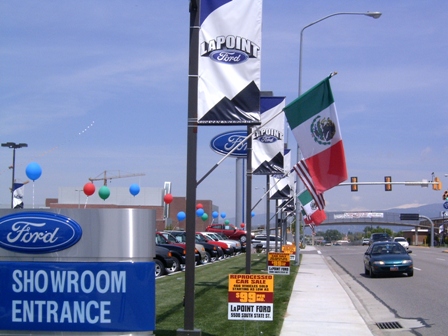
This Ford dealership in Murray, Utah, proudly
hoists Mexican flags. Courtesy of
utahminutemen.com, which will be staging a protest of such
businesses on June 17, 2005.
(click on picture to enlarge) |
Russell Sias: Russell
Sias: According to my understanding of what Immigration
Customs Enforcement agent David Ward, who works here in Utah,
has stated, 80% of crimes in the Salt Lake Valley are
committed by illegal aliens. He also states that 70% of ALL
construction labor in the state is being accomplished by
criminal illegal aliens. It has also been stated that 60-70%
of illegals in the U.S. are criminals and 20-25% are narcotics
dealers.
There is the issue of the
thousands of illegal aliens who voted in Utah’s last election…
Because of the partial audit of voting records, there is hard
evidence that they might be as many as 3400-3500 who actually
voted. The audit stopped looking when they discovered that 14%
of the first 100 voters they checked had improperly and
illegally voted.
[Note to the reader: Accountability Utah will
highlight this subject in a future article.]
Back to Topics
Question: Will the MMP happen again?
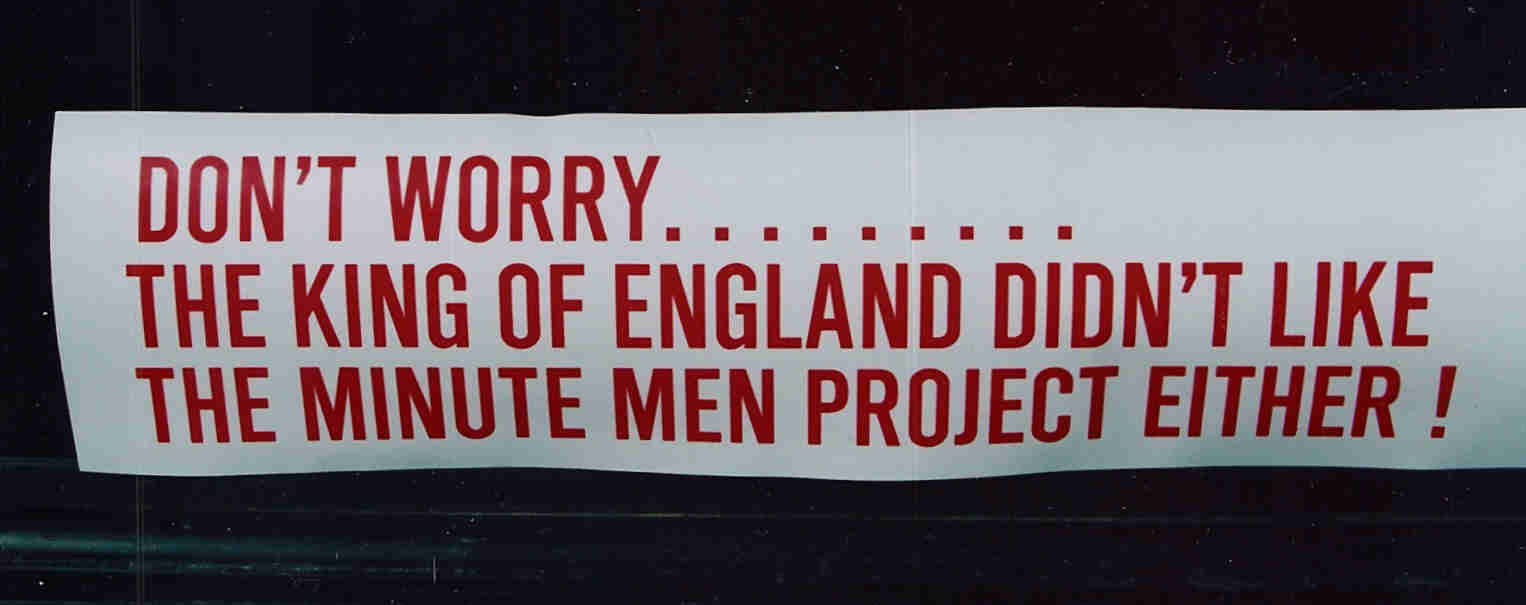
Pro-MMP bumper sticker.
(click on picture to enlarge) |
Russell Sias: Yes, the
plan is this next October. We hope others will come and join
the effort.
Jeff McNeil: It is a very
American thing to do.
Alex Segura: I highly
recommend it. I met some great people from New Hampshire,
Massachusetts, New York, Kansas, Texans, Californians and
Utahns. Most were just run-of-the-mill, salt-of-the-earth,
typical hard-working American citizens.
Wally McCormick: We are
organizing a Utah Minuteman Program (see
http://www.utahminuteman.com) available to citizens
who would like to help Utah protect what takes place within
our own borders. The citizens need to be aware and ready to
defend our State and Country against the present invasion. A
conservative estimate places 60-90,000 illegals already in
Utah.
Russell Sias: According
to the recently conducted partial audit, instigated by
Senators Bramble and Valentine, we have given over 98,000
driver’s licenses to people without social security numbers
(read criminal illegal aliens). It is my understanding that
there may be as many as 225,000 in the state presently.
Back to Topics
Accountability Utah
recipe: Take our information and opinion, research their
information and opinion (if it is available), and then examine
the law and draw your own conclusions. If you have
comments or suggestions, please email us at
info@accountabilityutah.org.
For more information on this
illegal aliens, see the
Illegal Aliens section of our Issues & Alerts page. |